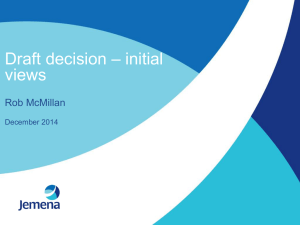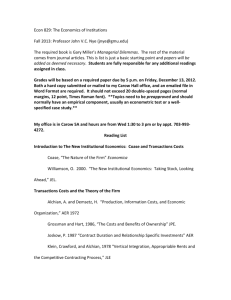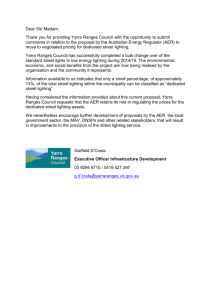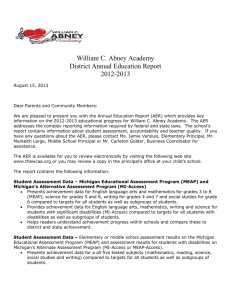Advice on AER preliminary decision and revised proposals
advertisement
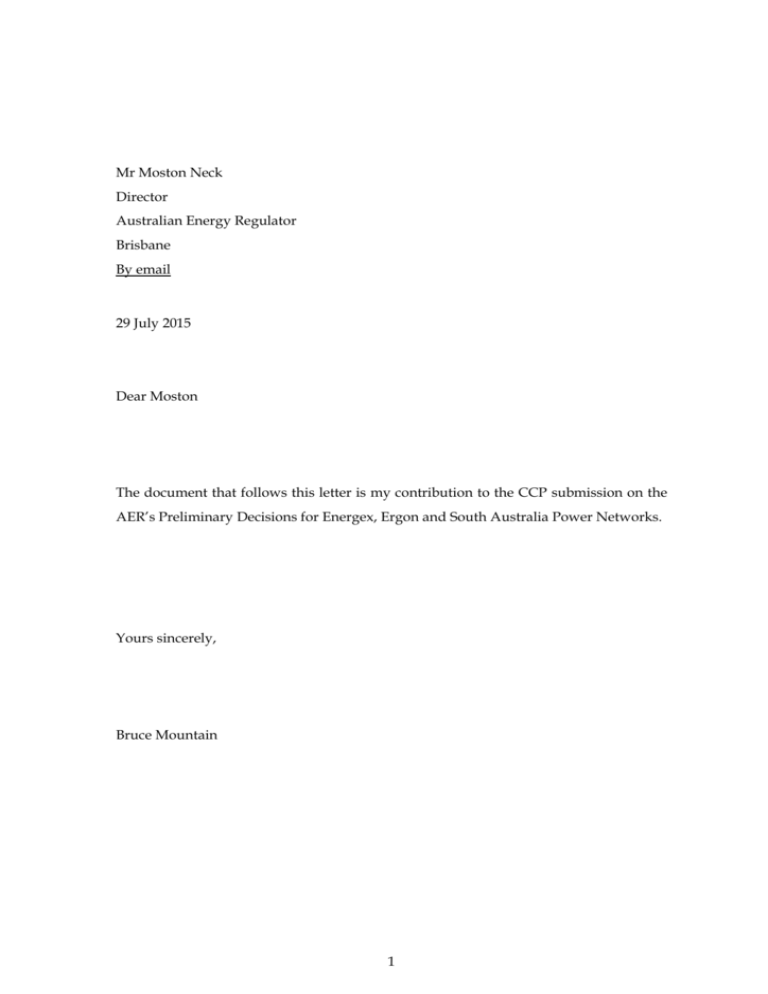
Mr Moston Neck Director Australian Energy Regulator Brisbane By email 29 July 2015 Dear Moston The document that follows this letter is my contribution to the CCP submission on the AER’s Preliminary Decisions for Energex, Ergon and South Australia Power Networks. Yours sincerely, Bruce Mountain 1 Table of Contents 1 Introduction ....................................................................................................................... 3 2 General comments ........................................................................................................... 3 3 Specific comments ........................................................................................................... 8 3.1 Averaging period for risk free rate ................................................................................... 8 3.2 Debt .............................................................................................................................................. 8 3.2.1 Credit rating ......................................................................................................................................8 3.2.2 Tenor ....................................................................................................................................................8 3.3 Equity ........................................................................................................................................... 9 4 3.3.1 Beta .......................................................................................................................................................9 3.3.2 Choice of CAPM model ............................................................................................................... 11 Ergon’s 132 kV network valuation ........................................................................... 12 2 Introduction 1 This section sets out my comments about the AER’s Preliminary Decision on the Weighted Average Cost of Capital (WACC) for Energex, Ergon and SA Power Networks. I make general comments (that apply to the calculation of WACC overall) and then a few specific comments (that apply in the calculation of specific elements of the WACC). General comments 2 I have three general comments: 1. More could be done to consider the evidence of past profitability and NSPs’ incentives to invest, in the assessment of WACC. 2. More could be done to compare the AER’s decision to that of other regulators. 3. Account needs to be taken of asset base indexation. More could be done to consider the evidence of past profitability and incentives to invest We suggest that the interests of consumers in the determination of the WACC is that the WACC is set at the lowest possible level that is needed to ensure network investment to meet consumers’ needs. The AER has set WACC for these three NSPs once already and in making the assessment of the WACC for the coming regulatory period it is very helpful to know: firstly, how profitable the NSPs have actually been (compared to what the AER had expected); second, the extent to which excessively generous allowed returns may have stimulated excessive investment (“gold-plating” in the vernacular); and 3 third how investors have responded to AER’s recent decisions including on WACC. On the first of these (actual profitability) we provided information and analysis in our January submission to the AER on the distributors’ proposals. In the Preliminary Decisions, the AER has reduced the premium to the risk free rate (WACC - Vanilla, nominal - less risk free rate) allowed to Energex, Ergon and SA Power Networks by 100, 80 and 80 basis points respectively relative to the decisions the AER made for the previous regulatory control period. These reductions are welcome but the AER has not responded to the information we provided on NSP profitability. We are not convinced that reductions in WACC of just 80-100 basis points are sufficient to ensure actual profitability in line with regulatory expectations. We again call on the AER to have regard to the information on actual profits in its calibration of the WACC for the coming regulatory control period. On the second of these (incentives for excessive over-investment) we draw attention to information presented at the predetermination conferences and repeated in Figure 1 below. The figure shows the expansion of substation capacity, per connection between 2006 and 2013, compared to the change in simultaneous peak demand, also per connection. It is clear from this that Energex, Ergon and SA Power Networks have invested very substantially more than was needed. This excess capacity now sits in their regulated asset base and consumers are paying for the depreciation and return on this excess capacity. The AER’s determination of WACC shows no recognition of the role that an excessively how WACC has played in stimulating waste investment. We call on the AER to take account of this information to justify its final decision on the WACC for the coming regulatory period compared to the last. 4 Figure 1. Change in substation capacity and peak demand between 2006 and 2013, per connection 10 Change in substation capacity and peak demand per connection between 2006 and 2013 (kVA, kW per connection) 9 Change in substation capacity per connection (kVA/connection) 8 7 Change in peak demand per connection (kW/connection) 6 5 4 3 2 1 (1) More could be made of the comparison of the AER’s WACC decision relative to that of other regulators The AER has compared the Market Risk Premium (MRP) that is has decided, with other regulators’ decision on the MRP. The main section dealing with this in the decision (section 3.4 of Attachment 3) provides a range for the MRP decided by other regulators. This range (5.5% to 7.9%) suggests that the AER’s decision (6.5%) is towards the lower end of the range decided by other regulators. However the data on the MRP that other regulators have set (albeit only for the last two years, shown in Figure 3.40) shows that there is just one regulator’s decision that has an MRP above 6.5%. We enquired about this and found that it relates to a Draft Decision (the Final Decision for the 2014/15 year set an MRP of 6%). Table 3.40 also shows that the majority of other regulators set an MRP of 6.0%. In Western Australian and the Northern Territory, the only other electricity decision, rates of 6% have been set. 5 A more accurate portrayal of the Market Risk Premium that the AER has set, relative to other regulators in Australia, is therefore that the AER’s rate is above the median and average rate that other regulators have set, not towards the lower end of the range as the AER has portrayed. In addition, on page 412 of Attachment 3, the AER provides a brief comparison of the Equity Risk Premium that it has set compared to just six other utility monopolies in Australia. Only one of these decisions have set an Equity Risk Premium higher than the AER. Again the comparison suggests that the AER’s decision is at the top end of the range set by other regulators for utility monopolies. We call on the AER to develop a more complete comparison and to explain why it has set a higher equity risk premium than other regulators have set. Account needs to be taken of asset base indexation for inflation In our January submission on the NSPs’ proposals we alluded to the need to take account of the revaluation surpluses that arise as a result of the indexation of the RAB for inflation, in considering NSP profitability and the return on equity: “ …the AER’s determination of the return on equity is based on an equity risk premium that is established with respect to a market in which accounting values of tangible assets are generally based on historic costs and where, if ever, upward revaluation above cost are reflected in statements of comprehensive income and so will be reflected in the market equity risk premium ”. To elaborate on this concern, the Market Risk Premium is a measure of the nominal returns to equity. However in the determination of the return on assets in setting regulated revenues, the AER applies the WACC that it has determined to a regulated asset base that is indexed for inflation. If, instead, the asset base was valued in a manner consistent with the market in which the market risk premium is established, the asset base should be based on historic costs, not an asset value that has been indexed for inflation. 6 In other words, to produce a WACC that will deliver a market risk premium consistent with the specification of the market risk premium, the AER either needs to reduce the regulated valuation to historic cost, or it needs to reduce the element of the market risk premium that compensates consumer price inflation, to take account of the fact that the regulated asset has already been indexed for consumer price inflation. We call on the AER to formally consider this in the determination of the WACC. 7 3 Specific comments 3.1 Averaging period for risk free rate I understand that the AER has agreed with the network service providers, the averaging period for the calculation of the risk free rate and that this agreed averaging period is confidential. I can see no compelling reason for such confidentiality: surely that AER is not suggesting that publication of the averaging period will affect the yield on 10-year Australian Government bonds? In the absence of a justification to the contrary, I suggest that the averaging period for the risk free rate should be as close as possible to the start of the regulatory control period and that it be made publicly available. 3.2 Debt 3.2.1 Credit rating The AER has said that it will use a BBB+ credit rating in setting borrowing costs. But the AER has actually used a broad BBB definition in establishing the benchmark. We call on the AER to consider how the allowed return on debt derived from its BBB benchmark should be reduced to reflect its chosen BBB+ benchmark rating. This is necessary not just for consistency with the AER’s benchmark, but also in view of the AER’s evidence that NSP debt is typically rated at BBB+ or higher. 3.2.2 Tenor I do not agree that 10 years is the suitable tenor. I see no reason for extrapolation from 7 years, considering the AER’s evidence that weighted average NSP bond tenor is around 7 years. This will have the additional benefit of avoiding the need for the AER to extrapolate the data series from 7 years to estimate the 10 year cost of debt. Such extrapolation undermines the accuracy of the market data. 8 In previous submissions to the AER, the CCP has suggested that the AER has regard to actual NSP borrowing costs. In response the AER has said “we do consider it may be useful to have some regard to service providers' historical actual borrowing costs”. But the AER has rejected the application of such information because the CCP has not told the AER how to do it. Rejection on this ground is not plausible. I call on the AER, again, to assemble and publish data on actual borrowing costs and to take account of this information in its final decision on the return on debt. 3.3 Equity 3.3.1 Beta Professor Olan Henry has, for many years, provided empirical analysis for the AER of the value of Beta for a number of Australian energy companies. His estimates, regardless of regression model chosen, show low standard errors. His average point estimates of Beta tend to cluster about 0.5, while the median point estimates are clustered about 0.4. The AER has described this analysis as “empirical evidence on equity beta for our comparator set of nine Australian energy network firms”. And the AER draws from Professor Olan’s report to conclude that the plausible range for Beta is 0.4 to 0.7. We suggest that the AER has not correctly described the comparator firms in Professor Olan’s analysis and neither has it concluded the plausible range of Beta for these firms. Four of the nine firms (Alinta, AGL, Hastings Diversified Utility Fund (HDUF) and APA) in Professor Olan’s study are not regulated network companies: Alinta was a gas retailer from listing (in 2000) to 2003. In 2003 it became a part owner and operator of regulated assets in western Australia and Victoria, but these were partly separated into a separately listed entity, Australian Infrastructure Holdings. Alinta was subsequently involved in a complex series of merger and demerger transactions, then an attempted management buyout and finally acquisition by a consortium and was delisted in late 2007. 9 Considering the tumultuous history of this firm and the fact that it only had a part stake in regulated assets for part of the period, Alinta can not reasonably be included in this analysis. AGL has only ever had a very minor interest in some gas pipelines in the past and it no longer has any interest in networks. HDUF was delisted in 2011, but when it was still in business it was an investment fund, not a network business. Its main investment was in an unregulated gas pipeline. APA’s principle business is the ownership and operation of unregulated gas pipelines, although it has management contracts (but not ownership) of some regulated assets. HDUF, Alinta, AGL and APA must therefore be excluded from the dataset. Having excluded these firms, remaining four firms are dominated by regulated network businesses and their beta’s range between 0.21 and 0.32, with a median and mean of less than 0.3. In addition, for completeness we stress that we are concerned if the AER’s decision is motivated by the theoretical considerations of the Black CAPM. The AER’s advisors have provided a substantial critique of the Black CAPM theory and practice given the inconstant assessments of the value of the zero-beta portfolio. McKenzie and Partington (2014), for instance, state that: 1 While we do not think such an adjustment is appropriate [to the SL CAPM], if one were to consider making an adjustment it is not clear what adjustment you should make to the CAPM return estimate. The problem is that the difference varies between studies, between sample periods …and is potentially sensitive to the choice of market index or proxy for the risk free rate. I agree with Mckenzie and Partington. 1 McKenzie and Partington, Report to the AER, Return on Equity, October 2014, p. 23. 10 Taking account of this, we call on the AER to revisit Professor Henry’s advice and ensure it selects an appropriate dataset of what might reasonably be called “Australian energy network firms”. If, after having done so, the AER chooses a Beta higher than is consistent with the median or mean of the appropriate dataset (i.e. less than 0.3) we call on the AER to provide a justification for such decision. 3.3.2 Choice of CAPM model The choice of the form of the Capital Asset Pricing Model (Sharpe-Lintner, Black, Wright, Fama-French) and the Dividend Growth Model has been considered at length in the AER’s preliminary decision. As the AER notes in the 45 or so valuation reports it examined over 18 months from 2013, the SL CAPM was used in all but one report. The network service providers’ consultants’ reports have urged the AER to use other models which they say deliver higher estimates of equity costs. The CCP is unconvinced by their arguments. If the NSPs’ consultants are convinced of their analysis (i.e. that they are right and the methods used by valuers are wrong) they might first seek to explain this to the academy and then to convince valuation practitioners. Evidence that their propositions are persuasive in these realms might be a suitable hurdle for them to pass before they can be considered credible in regulatory decisions. In the absence of any such evidence, we fully support the AER’s exclusive reliance on the SL CAPM model. 11 4 Ergon’s 132 kV network valuation As the AER knows, I have been concerned about unexplained changes in Ergon’s 132kV asset valuation. I am recording these concerns in this submission to ensure that they are in the public domain with the hope that the AER, Queensland Government and Board of Ergon Energy will investigate these concerns further. Ergon’s asset valuation per connection is bizarrely high compared to other distributors in Australia and even more so in comparison to distributors in other countries. Figure 2 below compares Ergon’s asset value per connection compared to all other distributors with more than 35 000 connection in Australia, New Zealand, Norway, Britain and Ontario. Figure 2. Regulated asset base per connection for electricity distributors in Australia, New Zealand, Ontario, Norway and Great Britain 4,000,000% 3,500,000% 3,000,000% 2,500,000% 2,000,000% 1,500,000% Ergon in 2013 1,000,000% 500,000% Ergon in 2006 ! $! $2,000% $4,000% $6,000% $8,000% $10,000% $12,000% $14,000% Source: Data from regulatory reports from AER, Ofgem, NZ Commerce Commission, Ontario Energy Board, Professor Tooraj Jamasb, Frontier Economics (London), CME analysis From Figure 2 it is clear that Ergon’s asset value per connection which was already higher than all other distributors in 2006 had become profoundly higher in 2013. I examined the AER’s Regulation Information Notices to seek to understand this better 12 and found that between 2006 and 2013 Ergon’s 132 kV network had reduced from 4,545 kM to 2,519 kM (i.e. by 2,026kM). In response to my questions, Ergon says 387.5 kM of 132kV line was sold to Powerlink for $40m. Ergon says a further 600kM of the difference was the result of a “data cleanse”. Ergon has not explained the remaining 1050kM reduction. In addition, despite halving the length of the network, the value of Ergon’s overhead circuits above 33kV increased by 38% in constant currency. Ergon has offered no explanation for this, but has instead pointed to the additional expenditure it has incurred in zone substations. I am concerned that such extreme errors have been made in Ergon’s regulatory accounts and that no plausible explanation has been offered for these errors despite my repeated requests. That Ergon could have found that it over-stated the length of its 132 kV network by almost 50% and then after the reduction in length, actually increase the value of its overhead circuits above 33kV by 38%, is bizarre. I call on the AER to commission an independent audit of Ergon’s regulated asset base and to allow that the results of this audit be made publicly available. 13


